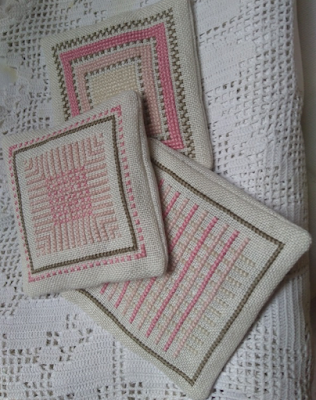Liz suggests that "We follow in a time-honoured tradition when we stitch to decorate functional objects" and she and Wendy spent some time collecting photos of some of the wonderful items members have been creating that are useful as well as decorative. This is no doubt only the tip of the iceberg, and our very productive members could showcase many more.
Cushions are a perfect item to demonstrate the art of stitch. Here’s a glorious example from Mary covered in a grid of different, carefully executed stitches.
Another Zara project was this stool by Wendy. Woollen fabric was used for the top and then it was hand embroidered. She says the sewing of the stool was far more successful than the wooden base, as it has a very wonky leg!
Here's a close-up, so you can really see the intricate work:
Having a crop of lavender flowers each year has encouraged Liz to make lavender bags. These are on linen in stranded cotton using Scandinavian inspired grid patterns.
These beautiful Dorset button samples are Gaye's work. The tradition dates from the time when buttons were not plastic or mass produced, and you can see below a traditional white one worked large scale in its simplest form with a single length of thread and a ring.
To create a traditional Dorset button like this: wrap the thread around the ring to cover it, several wheel spokes are then wrapped across the diameter of the ring and secured in the centre; the same thread is used to weave under and over the spokes to make a spider’s web design. Using different types of thread, colours, changing weave direction and adding beads all demonstrate how this simple traditional technique can be brought up to date – the variations are endless, especially if you experiment with size and thickness of the rings or washers.
The fabric for this piece was begun in the Zoom mini-workshop with Jayne Emerson. Liz made it into a pen roll, seen here rolled up and ready to go.
The elastic was attached to the lining and to a piece of cotton wadding; the tapes were held in the side seam and the pieces assembled, bagged out and the turning space slip stitched.
A cover for a sketchbook was made with a second piece. So she just needs to get sketching now!
Bags of all sorts are always handy, from shoppers to pouches for small items. Here are some that members have been making.
These two are from kits by Anglo Japan that had been waiting patiently in the cupboard for a rainy day. Covid-19 lockdown provided the incentive for Liz to get them put together! They were really fun little projects and are a useful size for slipping other projects inside!
Gaye made this lovely hand felted bag, finishing it with another type of handmade button called a Singleton. These were a kind of Dorset button named after the Singleton family who first made them in the 1660s. This has a metal ring covered with black felt which has been embroidered in colours to match detail in the felt bag.
Dorothy's two pouches are made of sari silk strips woven together and then machine stitched. Even the dullest sari silks can be brightened up into something very colourful, and Dorothy likes to use something special for the lining to give the opener a surprise. They can equally be made into bags and tablet/computer covers and given as gifts.
Gill also stores her embellisher foot pedal and spare needles in this delightful sunny storage bag, which has zipped side pockets.
This lampshade in subtle tones of grey was made by Gill at the beginning of lockdown. The fabric was woven on a Saori loom. She says it was a nightmare to stop the edges fraying even though it was stitched to a lightweight background on the sewing machine and it ended up being salvaged by a tube of super glue! But it was well worth the effort, Gill!
Dorothy based this beautiful sewing kit on an idea from a magazine, but the stitching design is her own. It neatly holds all the basic sewing requirements,
while a summer school by textile artist, Jayne Emerson inspired Margherita’s colourful needle case.
Wendy has created items that are not only useful, but mindful of resources by using vintage embroidered tablecloths and pillow cases for these padded coat hangers. It can be difficult to cut into old items that have sentimental value, so it's best to choose some well-worn fabrics with tea stains or small holes! The small pouch was also repurposed from a table cloth.
A footstool with a chequered history! Liz bought the kit at Charlecote Park many years ago when she was new to tapestry and badly distorted the piece by not working it in a frame. It was relegated to the back of a cupboard, together with the wooden proforma bought at roughly the same time. Added to the list of UFOs to be completed during lockdown, it was stretched; found to be too small for the stool top; new wool was purchased over the internet, hoping the colours were right! Then Liz chickened out of assembling it and took it to an upholsterer – and is so pleased with the result, woe betide anyone who puts their feet on it!
As was said at the start, once we start looking around our homes, we are likely to find numerous items that fall into the category of functional objects that have been decoratively stitched.
We may also have items made before our times by family members or by friends that fall into this category. There is an abundance of hand-stitched table linen, of course - something not many of us stitch ourselves these days - sitting in drawers or cupboards, and it really seems a shame to keep all this treasure hidden away. Just a thought ...





























No comments:
Post a Comment